In July 1855, a group of surveyors scouting locations for the third Massachusetts State Hospital for the Insane visited Northampton, Massachusetts. They noted that “Northampton presents facilities in point of salubrity of climate, pure water, ease of access and a central location not to be surpassed.”1 Less than a year later, on February 26, 1856, construction began on what was originally named the Northampton Lunatic Asylum.2 It was built on the west side of the Mill River; just under twenty years later, Smith College was first built across the banks. By the early 20th century, the name had changed to the Northampton State Hospital, which it remained. The hospital was in operation until 1993, at which point all remaining patients had been reassigned, and the buildings were abandoned.3
While today, there is little physical trace of the hospital on the Smith College campus, this was not always the case. Until the early 2000s, when the hospital ruins were torn down, students at Smith would have been able to see the main hospital building from where it stood across the Mill River. Furthermore, there is a long history of interactions between the two institutions, in terms of education, work, and land, as well as cultural and societal conventions. In this exhibit, I hope to track some of these interactions and overlapping history, to explore what these two institutions meant to each other, and how the Northampton State Hospital impacted life at Smith and vice versa.
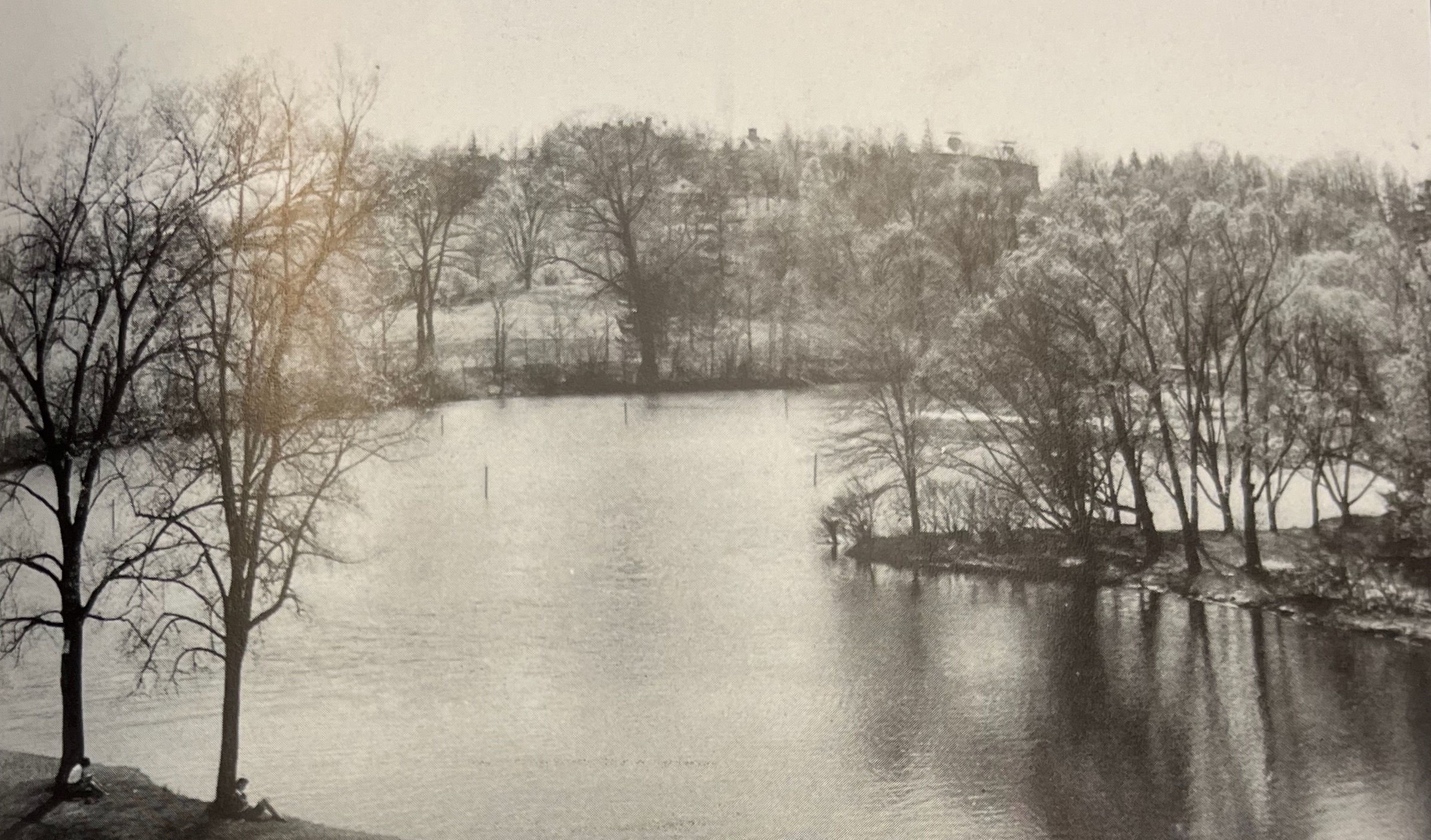
“Smith College and the hospital shared Paradise Pond between them, which blurred the edges of the two institutions. When the sun went down, the hospital could be seen from the Smith College Campus, clearly silhouetted against the sky.”4
View of Northampton State Hospital buildings atop Hospital Hill, as seen from Smith College Campus, date unknown. Northampton State Hospital Collection, Historic Northampton.
Shared Land
As its student population grew in the early 20th century, the Trustees of Smith College became interested in increasing expansion. In 1920, President Neilson began making inquiries about buying the land from the Northampton State Hospital that sat on the other side of the Mill River. In 1922, a bill was approved by the Commissioner of Mental Diseases to allow Smith College to buy this land for about $50,000 – which would amount to just under one million dollars today. Over the next few years, the college would develop this land into the current athletics fields.5 The campus maps below show the changing ownership and use of the grounds between 1915 and 1933.
While the athletics fields became officially owned by Smith College at this point, in the decades following students were still allowed access to other parts of the Northampton State Hospital grounds for various activities, including skiing and sledding. Even now, one of the most popular sledding hills in Northampton is what’s still known as Hospital Hill, and is former Northampton State Hospital land.
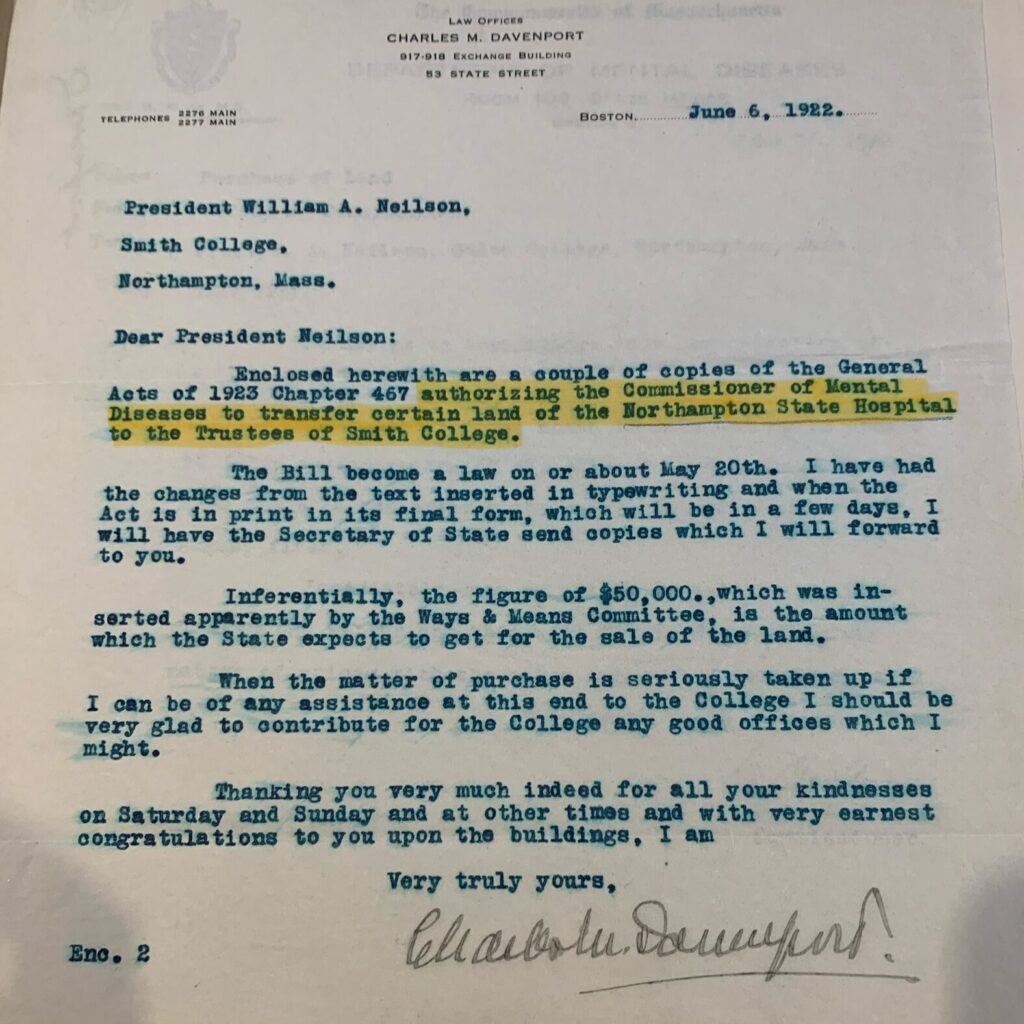
Smith College campus maps, 1915-1933. Grounds subject files, Smith College Archives.
- As a student at Smith now, is the history of Hospital Hill discussed? What of this history is generally known today?
Classes and Lectures
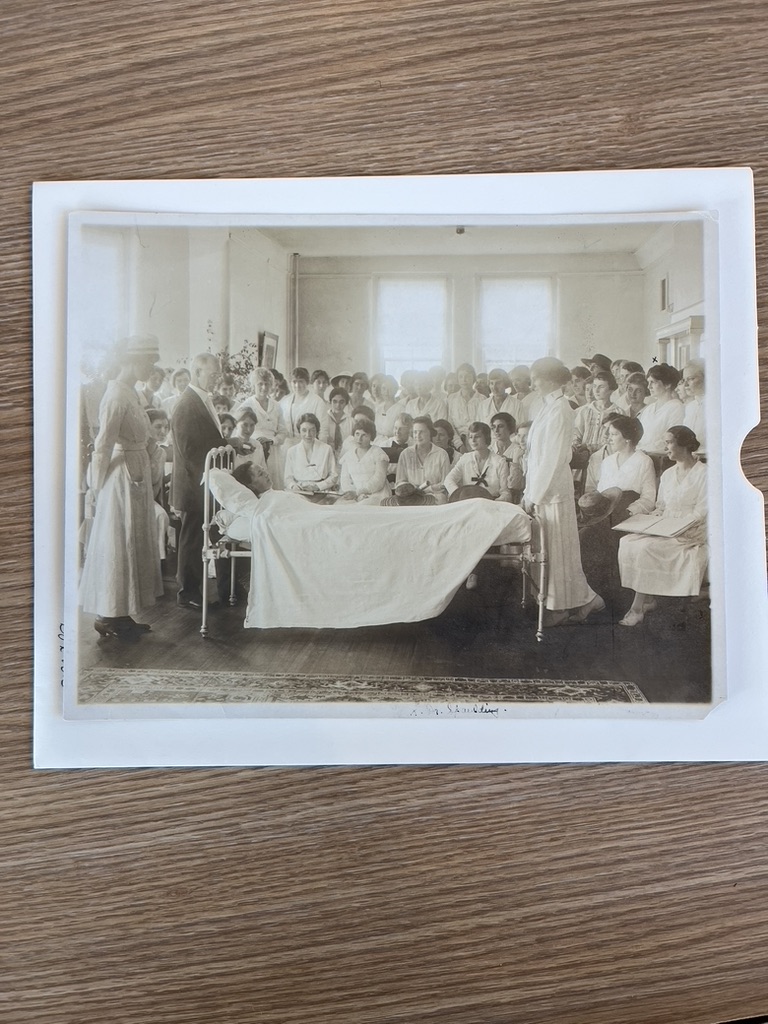
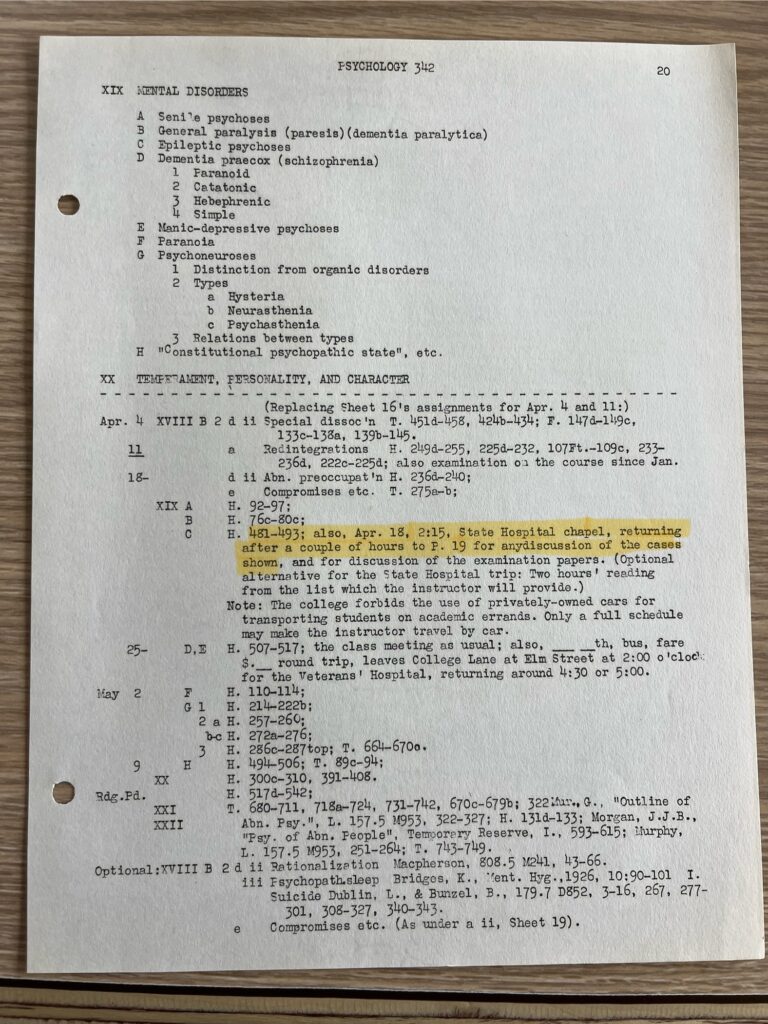
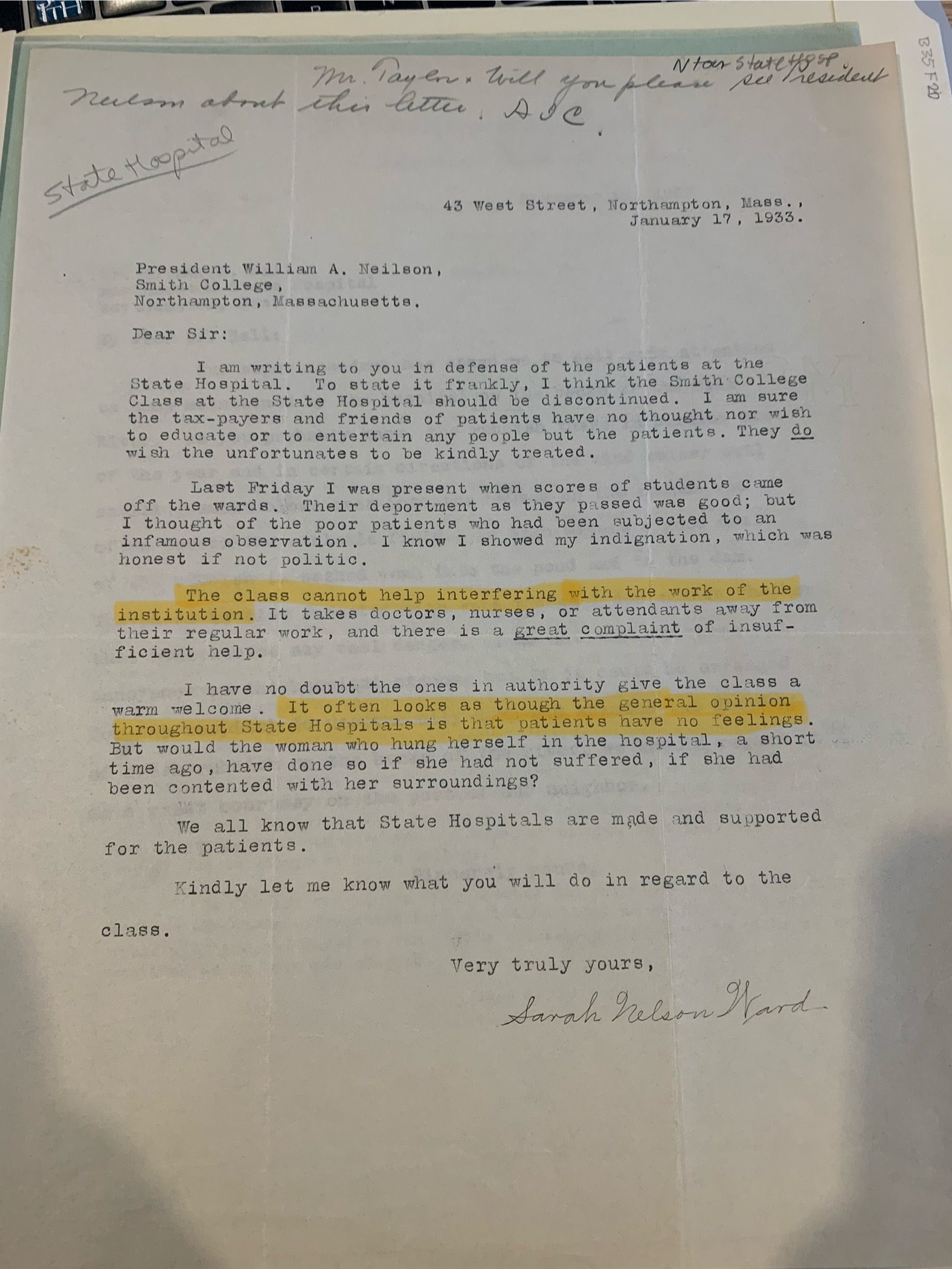
Another way that Smith college students and faculty interacted more closely with not only the hospital land but the patients and staff living and working there was through classes and lectures. Throughout much of the first half of the 20th century, Smith classes – particularly psychology classes and classes at the School for Social Work – visited the hospital to learn by observing its patients and practices. In 1919, the first year that the School for Social Work was in operation, the then-Superintendent of the Northampton State Hospital, Dr. John A. Houston, delivered lectures and clinics to students that directly involved individual patients.6
The practice of classes visiting the hospital continued at least through the 1930s, as can be seen by the above syllabus from Professor William Sentam Taylor’s class on Abnormal Psychology, which showed that he and his students visited the hospital on April 18, 1935, though students had an option to do an extended reading if they chose not to come to the visit.7 While it’s clear that the hospital administration supported these visits, this was not true of everyone. Sarah Nelson Ward wrote to President Neilson in 1933 after she was at the hospital while students visited, and objected to the practice. Importantly, she noted that it wasn’t the attitude or the actions of the students that were a problem, but that it distracted from the actual goal of the hospital by pulling doctors and nurses away from their work and that the practice itself was disrespectful to the patients.8
“It often looks as though the general opinion throughout State Hospitals is that patients have no feelings… We all know that State Hospitals are made and supported for the patients.”
Sarah Nelson Ward to President Neilson, 1933.
Despite Ward’s request, there is no record of Neilson’s response to her objections. Based on the dates of this letter and of Taylor’s syllabus, it’s clear that these visits continued in the years after she wrote to Neilson.
- The photograph of Dr. Houston was taken as a part of promotional material for the newly-created School for Social Work. How might a photo like this be seen today, and do you think it would have the same effect as promotional material as it did in the past?
- Some of Professor Taylor’s publications during this time focused on “Mental Hygiene,” which is an indicator of eugenic thinking. What might this context show about the focus of his class and the perspective he taught about patients at the hospital?
- How would you address or respond to Sarah Nelson Ward’s concerns had you received this letter?
Nine College Volunteer Program
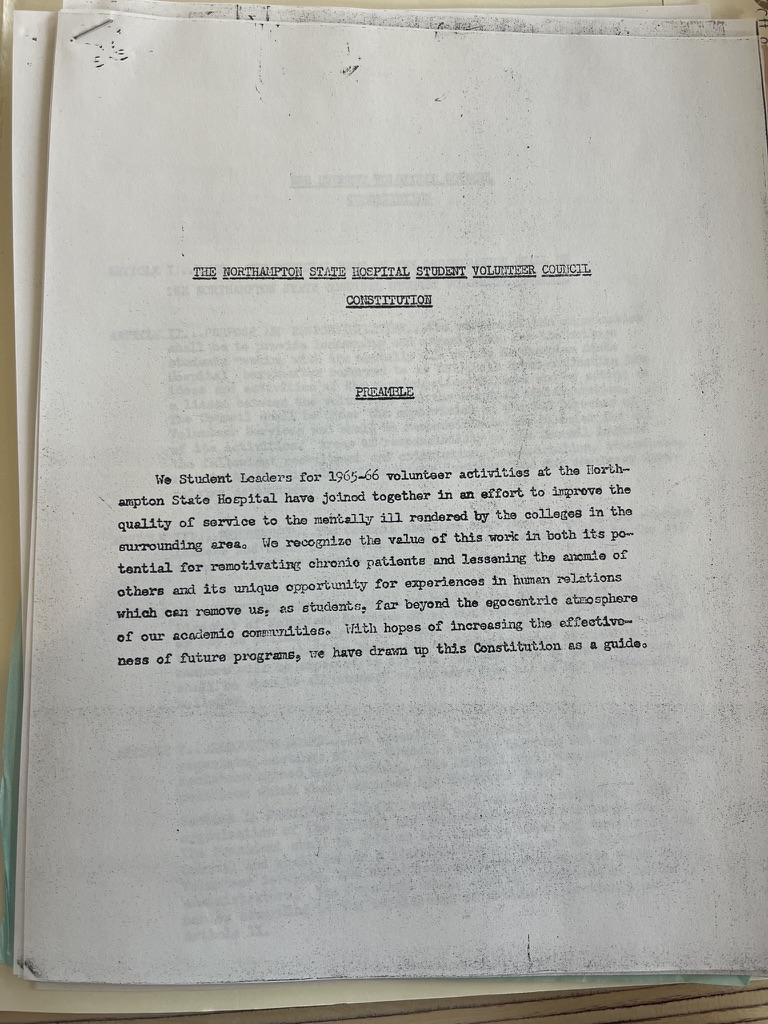
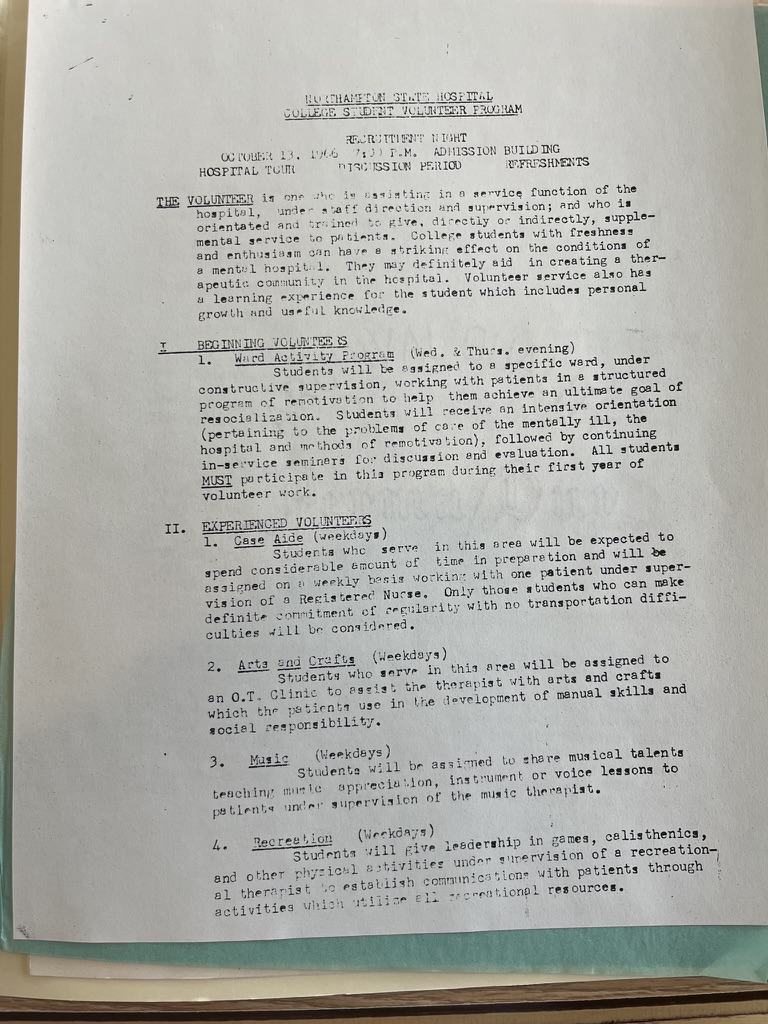
Throughout the 1950s and 60s, students from many of the surrounding colleges volunteered at the Northampton State Hospital as a part of the Nine College Hospital Volunteer Program. Beginning volunteers worked in the Ward Activity Program, under supervision, with a focus on “re-socialization” and “re-motivation” for patients, and also received an intensive orientation. More experienced volunteers could work in a variety of positions, including being a Case Aide for an individual patient, or working on programs in Music, Arts and Crafts, or Recreation. This program appears to have been very well received by both Smith and the hospital, according to letters exchanged between President Mendenhall and various directors and supervisors of the program at the hospital, and was nominated for the Lane Bryant Award in 1966. Mendenhall wrote that he saw the program as an important element of connection between the college and the wider Northampton community, and as a part of a larger movement of programs designed to bring Smith students in contact with other local groups.9
“I’m delighted to write in support of what has proved to be an extraordinarily exciting and rewarding venture for both parties, the undergraduates and the patients in the hospital.”
President Mendenhall to Dana Fisher, 1967
Various Smith students took on leadership roles throughout the process, and incorporated their own passions, such as sophomore Susan Lowry who in 1967 proposed bringing dance therapy to her volunteer work, though her program shifted according to the needs of the hospital patients. The same year, in 1967, around 76 Smithies were involved in the program.
The 1965-66 constitution for the volunteer group also emphasized the goal of re-motivation for patients, as well as the opportunities for community engagement. While we don’t have accounts of patients’ experiences with this program – which would be vital to a fuller analysis of these events – students and hospital workers viewed it as a positive exchange between the two institutions.
- What programs would you be interested in being a part of if you were involved in the Nine College Volunteer Program?
- What agency do you see this program and interaction providing for patients at the hospital? What agency for students?
Further Research
For more background on the history of Northampton State Hospital, including oral histories surrounding its deinstitutionalization: Northampton State Hospital
Anna S. Haber created a memorial project for the hospital prior to its demolition in 2006, which included hearing from former patients: Habeas Corpus – by Anna Schuleit Haber, at Northampton State Hospital, The Moth | Stories | The Magnificat.
Archival Collections:
Office of the President Records: President Neilson, President Mendenhall, President Conway
Smith School for Social Work Records: Photographs, 1919-2002
Secondary Sources
Horowitz, Helen Lefkowitz. “Smith College and Changing Conceptions of Educated Women.” In Five Colleges: Five Histories, edited by Ronald Story. Five Colleges, Inc., 1992.
Horowitz explores the founding of Smith College, with a focus on how its design was meant to inform the lives of its students within Smith and afterwards. She also places Smith’s design in context with that of Vassar and Mount Holyoke, which helps to understand the overarching relationships between Historically Women’s Colleges and mental institutions, particularly in terms of surveillance and patriarchal ideals.
Upshur, Carole C, Paul R Benson, and Elizabeth Clemens. “Closing State Mental Hospitals in Massachusetts: Policy, Process, and Impact.” International Journal of Law and Psychiatry 20, no. 2 (1997).
This paper provides an important overview of the impacts of the closing of multiple Massachusetts State Hospitals in the second half of the 20th century, including the Northampton State Hospital. The hospital being shut down was a complicated and ongoing process, and this article helps to place it in context with the wider view of mental institutions in the state and in the country.
Yanni, Carla. The Architecture of Madness: Insane Asylums in the United States. NED-New edition, University of Minnesota Press, 2007.
Yanni analyzes the architecture and the history of design of mental institutions within the United States. Of particular interest are the chapters on the Kirkbride plan, which is the style that the Northampton State Hospital was built under, and the chapter on the Cottage Plan, which inspired Smith’s design and early house system. This book provides important background information for the ways in which institutional design imparts the values of their founders, even as the institutions themselves evolve.
*Note: all highlighted sections of documents were added to photographs by me for clarity, and are not a part of the original item.
Works Cited
- Daily Hampshire Gazette, July 17, 1855. ↩︎
- Daily Hampshire Gazette, February 26, 1856. ↩︎
- “A Brief History of Northampton State Hospital,” Northampton State Hospital, https://northamptonstatehospital.org/. ↩︎
- J. Michael Moore and Anna S. Haber, Northampton State Hospital (Arcadia Publishing, 2014), 85. ↩︎
- Correspondence on sale of hospital land. The Office of President William Allan Neilson files, Smith College Archives, CA-MS-00013, Smith College Special Collections, Northampton, Massachusetts. ↩︎
- F. Stuart Chapin. The Smith College Training School for Social Work. May 1919. ↩︎
- Psychology 342 syllabus. Department of Psychology records, College Archives, CA-MS-00076, Smith College Special Collections, Northampton, Massachusetts. ↩︎
- Letter from Sarah Nelson Ward to President Neilson. The Office of President William Allan Neilson files, Smith College Archives, CA-MS-00013, Smith College Special Collections, Northampton, Massachusetts. ↩︎
- Correspondence and documents on Nine College Volunteer Program. Office of the President Thomas Corwin Mendenhall Files, Smith College Archives, CA-MS-00032, Smith College Special Collections, Northampton, Massachusetts. ↩︎
